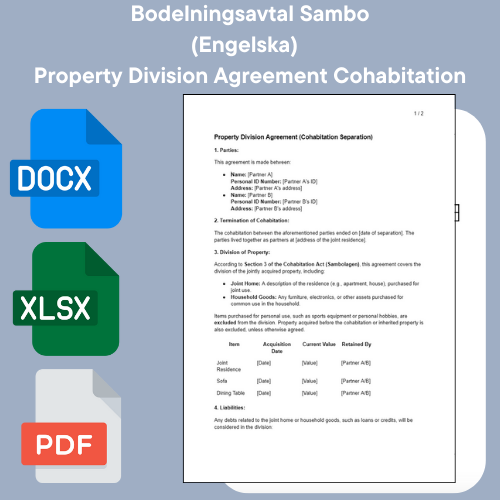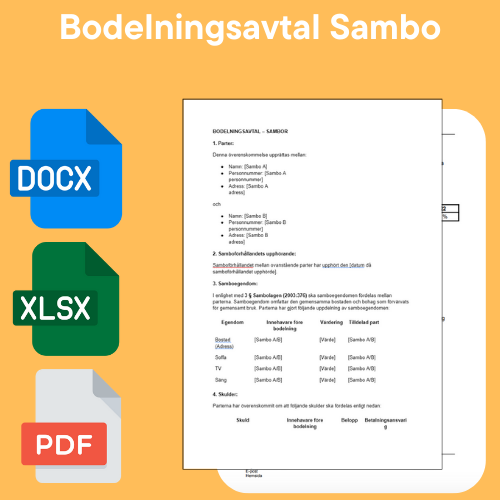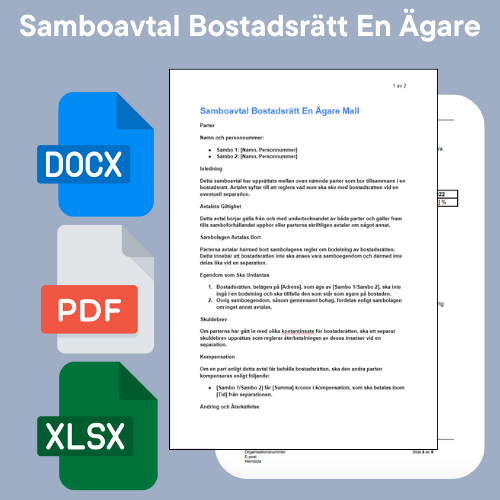Cohabitation Agreement Template - Everything you need to know
Share
Cohabitation Agreement Template
Table of Contents
- What is a Cohabitation Agreement?
- What does the law say?
- What is Required by the Law?
- What Should You Think About?
- How to Draft a Cohabitation Agreement
- Common questions
- Common Mistakes
- Summary
What is a Cohabitation Agreement?
A cohabitation agreement is a legal document that regulates how property should be distributed between two people living together in a cohabitation relationship should they separate. The partnership agreement can be adapted to specific needs and may deviate from the standard distribution stated in Partnerships (2003:376).
What does the law say?
According to the Partnerships, all cohabiting property, which includes housing and household goods that have been acquired for joint use, must be divided equally between cohabitants in the event of a separation. A cohabitation agreement can, however, exclude certain property from the division of property and thus adjust the division according to the wishes of the parties.
What is Required by the Law?
For a cohabitation agreement to be legally valid, it must meet certain formal requirements:
- Writing: The agreement must be in writing and signed by both parties.
- Date: The agreement should be dated to make clear when it was entered into.
- Signature: Both parties must sign the agreement. It is recommended that the agreement be witnessed by two outsiders to strengthen its probative value.
What Should You Think About?
When drawing up a cohabitation agreement, there are several important aspects to consider:
- Communication: Discuss openly and honestly with your partner about what you want to regulate in the agreement.
- Consultation: Consider consulting a lawyer to ensure that the agreement meets all legal requirements and protects the interests of both parties.
- Flexibility: Be prepared to revise the agreement if necessary if your circumstances change.
How to Draft a Cohabitation Agreement
To draft a legally correct cohabitation agreement, follow these steps:
- Identify the parties: Enter the full name, social security number and address of both parties.
- Describe the assets: List the assets to be excluded from the division of property and indicate to which party they should go.
- Specify exceptions: Specify which assets are not to be covered by the Partnership's property division rules.
- Dates and signatures: Date the agreement and have both parties sign it. Feel free to witness the signatures.
Common questions
Here are some common questions and answers about cohabitation agreements:
-
Does a cohabitation agreement have to be witnessed?
No, it is not a requirement, but it is recommended to strengthen the probative value of the agreement. -
Can a cohabitation agreement be changed?
Yes, a cohabitation agreement can be amended by drawing up a new agreement signed by both parties. -
What happens if we do not have a cohabitation agreement?
If you do not have a cohabitation agreement, the property division rules of the Partnership apply, which means that all cohabitation property must be divided equally in the event of a separation.
Common Mistakes
Avoid these common mistakes when creating a cohabitation agreement:
- Unclear wording: Make sure the agreement is clear and specifies exactly which assets are covered.
- Incorrect information: Double-check that all information in the agreement is correct and up-to-date.
- Lack of update: Update the agreement if necessary if your circumstances change.
Summary
A cohabitation agreement is an important document that helps regulate how property should be distributed between two people in a cohabiting relationship in the event of a separation. By following the legal requirements and the steps described above, you can create a cohabitation agreement that protects the interests of both parties and avoids future conflicts.
Consulting a lawyer to ensure that the agreement is properly drafted can be a wise investment. With a clear and correct cohabitation agreement template, you can feel secure that your assets are distributed according to your wishes.




